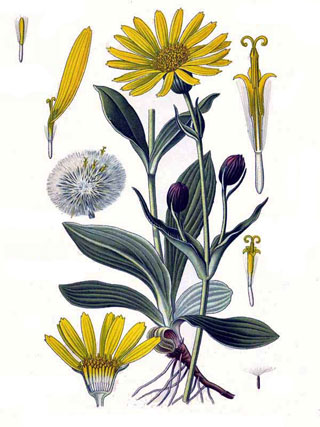Arnica – Arnica montana L.
Perennial herb up to 60-80 cm, families slozhnotsvetnыh (Combined). It grows mostly in the high meadows of the Carpathians and the Baltic states. Medical raw materials are arnica.

Arnica mountain – Chemical composition
Arnica montana flower baskets contain colorants lyuteyn, arnidiol and faradiol. In the flowers of arnica are tannic and resinous substances, organic acid (fumaric, malic and lactic), essential oil, vitamins (vitamin C), proteins, sugar, inulin, mix, alkaloids and other compounds.
Arnica – Pharmacological properties
The most active therapeutic role prinadlelsit coloring material faradiolu, which, when applied topically has irritant properties and promotes the resorption of hemorrhages. As a result of resorptive action arnitsina increases the amplitude of heart contractions, dilate coronary blood vessels, improves trophic heart muscle, evident hemostatic effect in diapedetic bleeding.
Using experimental studies found, that the amount of active ingredients Arnica speeds up the heart rate, It has a tonic effect on the spinal cord, in connection with the earlier highlights the tonic properties of the plant. Then it was discovered, that medicinal herbal form of arnica inhibit cortical centers, which explains the combination of sedation with an increase in reflex excitability of the spinal cord, which is a result of feedback occurs when removing the inhibitory effect of the higher parts of the central nervous system. Preparations of arnica flowers in small doses have a tonic effect on the CNS, and in large doses - Sedative, anticonvulsant action.
Besides, Arnica preparations have choleretic, anti-inflammatory effect and increase uterine contractions. Choleretic effect is due to resins and essential oil plants. Arnica also has anti-sclerotic properties, It lowers the level of cholesterol in the blood of animals, due to the presence in the plant tsinarin.
Arnica – Use in medicine
The infusion of arnica flowers administered topically in the form of wet dressings, lotions and poultices for bruises, ssadinax, gematomax, as well as a variety of pustular skin diseases, trophic ulcers, minor burns and frostbite.
In obstetric and gynecological practice arnica tincture is used as a hemostatic agent in poor uterine contractility in the postpartum period, during heavy menstruation and bleeding, inflammatory diseases associated with genital. The effectiveness of herbal plants in the form of these cases, close to the therapeutic effect of ergot drugs.
Because tinctures and extracts of Arnica flowers have a positive effect on the functional activity of the cardiovascular system, they are administered together with other drugs for angina, miokarditax, hypertensive disease, kardioskleroze.
As a sedative herbal form of arnica are now rarely used.
If overdose arnica may experience chills, breathlessness, nausea, Sweating, stomach ache, diarrhea or constipation, vomiting. In some cases, marked dysfunction of the cardiovascular system.
Arnica – Formulations, Dosing and Administration
Tincture of arnica It is a transparent liquid greenish brown, peculiar smell, Acute, bitter taste. Prepared from finely cut up flowers on 70 % alcohol. Apply 30-40 drops to a reception in water or milk as a styptic.
Infusion of arnica flowers: 10 g (3 tablespoons) flowers are placed in an enamel bowl, Pour 200 ml (1 glass) hot boiled water, capped and heated in boiling water (in a water bath) 15 m, cooled at room temperature for 45 m, filter, wring, top up with boiled water to the original volume (200 ml).
Take 1 tablespoon 3 times a day after meals with milk as a hemostatic and choleretic. Insist stored in a cool place no more 2 d.
Store in a cool, dry place.
